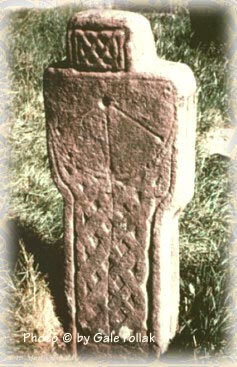Clogher, Co. Tyrone
selected passages from
"THE ANCIENT SUNDIALS OF IRELAND", by M.Arnaldi, edited by B.S.S.,
London, 2000
 |
| The Clogher' sundial before being tranferred inside the Cathedral (photo © Gale Pollak) |
Today, in that place, rises the Cathedral of St. MacCartan (built in 1818). The cemetery surrounding it is rich in ancient slabs, amongst which there was a sundial until 1969, but it is now situated inside the church. This is a rather worn sandstone slab, with an ugly long crack running through both faces, for more than half the length of the stele; however the sundial is clear and intact. The interior stone has the form of a rough cross, such that for a long time it was believed to be a tombstone. The appearance of this stone is very ancient, and some of the decorative features indicate a remote date of origin. The face, on which the sundial appears, shows a different form to all other Irish sundials. The body of the stele, with a small rectangular extension at the top, is decorated with an inter-laced design resembling basket work, under wich, in relief, is a well shaped fish. ...
On the rear face, now very deteriorated, one sees the indistinct face of a
man, and in the part that would correspond to the torso, is engraved a very
rudimentary cross. ...
The sundial is inscribed in a semicircle and shows three time lines, terminating
in a very deep mark. The segment angles follow the scheme 30, 90 and 150 degrees
that are common in the monastic sundials of Ireland.
Copyright© Mario Arnaldi